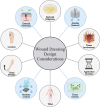Evaluating polymeric biomaterials to improve next generation wound dressing design
- PMID: 36183134
- PMCID: PMC9526981
- DOI: 10.1186/s40824-022-00291-5
Evaluating polymeric biomaterials to improve next generation wound dressing design
Abstract
Wound healing is a dynamic series of interconnected events with the ultimate goal of promoting neotissue formation and restoration of anatomical function. Yet, the complexity of wound healing can often result in development of complex, chronic wounds, which currently results in a significant strain and burden to our healthcare system. The advancement of new and effective wound care therapies remains a critical issue, with the current therapeutic modalities often remaining inadequate. Notably, the field of tissue engineering has grown significantly in the last several years, in part, due to the diverse properties and applications of polymeric biomaterials. The interdisciplinary cohesion of the chemical, biological, physical, and material sciences is pertinent to advancing our current understanding of biomaterials and generating new wound care modalities. However, there is still room for closing the gap between the clinical and material science realms in order to more effectively develop novel wound care therapies that aid in the treatment of complex wounds. Thus, in this review, we discuss key material science principles in the context of polymeric biomaterials, provide a clinical breadth to discuss how these properties affect wound dressing design, and the role of polymeric biomaterials in the innovation and design of the next generation of wound dressings.
Keywords: Biomaterials; Polymers; Tissue Engineering; Wound Dressings; Wound Healing.
© 2022. The Author(s).
Conflict of interest statement
All authors declare that they do not have any conflict of interest except Dr. David Zamierowski. Dr. Zamierowski declares that he has sold patents to the V.A.C. to KCI/Acelity and continues to receive royalties on Prevena (KCI/Acelity, now KCI/3M). Dr. David Zamierowski is the owner and founder of Zam Research LLC.
Figures













Similar articles
-
Polymer-based biomaterials for chronic wound management: Promises and challenges.Int J Pharm. 2021 Apr 1;598:120270. doi: 10.1016/j.ijpharm.2021.120270. Epub 2021 Jan 21. Int J Pharm. 2021. PMID: 33486030 Review.
-
Therapeutic Efficacy of Polymeric Biomaterials in Treating Diabetic Wounds-An Upcoming Wound Healing Technology.Polymers (Basel). 2023 Feb 27;15(5):1205. doi: 10.3390/polym15051205. Polymers (Basel). 2023. PMID: 36904445 Free PMC article. Review.
-
Synthetic polymeric biomaterials for wound healing: a review.Prog Biomater. 2018 Mar;7(1):1-21. doi: 10.1007/s40204-018-0083-4. Epub 2018 Feb 14. Prog Biomater. 2018. PMID: 29446015 Free PMC article.
-
A review of the current state of natural biomaterials in wound healing applications.Front Bioeng Biotechnol. 2024 Mar 27;12:1309541. doi: 10.3389/fbioe.2024.1309541. eCollection 2024. Front Bioeng Biotechnol. 2024. PMID: 38600945 Free PMC article. Review.
-
Polymeric biomaterials for wound healing.Front Bioeng Biotechnol. 2023 Jul 27;11:1136077. doi: 10.3389/fbioe.2023.1136077. eCollection 2023. Front Bioeng Biotechnol. 2023. PMID: 37576995 Free PMC article. Review.
Cited by
-
Therapeutic potential of luteolin-loaded poly(lactic-co-glycolic acid)/modified magnesium hydroxide microsphere in functional thermosensitive hydrogel for treating neuropathic pain.J Tissue Eng. 2024 Feb 7;15:20417314231226105. doi: 10.1177/20417314231226105. eCollection 2024 Jan-Dec. J Tissue Eng. 2024. PMID: 38333057 Free PMC article.
-
Multi-functional dressings for recovery and screenable treatment of wounds: A review.Heliyon. 2024 Dec 24;11(1):e41465. doi: 10.1016/j.heliyon.2024.e41465. eCollection 2025 Jan 15. Heliyon. 2024. PMID: 39831167 Free PMC article. Review.
-
Mesenchymal stem cell-derived secretomes-enriched alginate/ extracellular matrix hydrogel patch accelerates skin wound healing.Biomater Res. 2023 Oct 31;27(1):107. doi: 10.1186/s40824-023-00446-y. Biomater Res. 2023. PMID: 37904231 Free PMC article.
-
Natural Protein Films from Textile Waste for Wound Healing and Wound Dressing Applications.J Funct Biomater. 2025 Jan 10;16(1):20. doi: 10.3390/jfb16010020. J Funct Biomater. 2025. PMID: 39852576 Free PMC article. Review.
-
Collagen-Chitosan Composites Enhanced with Hydroxytyrosol for Prospective Wound Healing Uses.Pharmaceutics. 2025 May 6;17(5):618. doi: 10.3390/pharmaceutics17050618. Pharmaceutics. 2025. PMID: 40430909 Free PMC article.
References
Publication types
LinkOut - more resources
Full Text Sources
Miscellaneous

